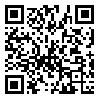Volume 18, Issue 4 (Vol.18, No.4, Winter 2023)
irje 2023, 18(4): 270-281 |
Back to browse issues page
Download citation:
BibTeX | RIS | EndNote | Medlars | ProCite | Reference Manager | RefWorks
Send citation to:



BibTeX | RIS | EndNote | Medlars | ProCite | Reference Manager | RefWorks
Send citation to:
Halimi L, Dortaj Rabari E, Majdzadeh R, Haghdoost A. Investigating the Impact of the Social Network in the Transfer of Puberty Information Among Adolescent Students in Hamadan. irje 2023; 18 (4) :270-281
URL: http://irje.tums.ac.ir/article-1-6685-en.html
URL: http://irje.tums.ac.ir/article-1-6685-en.html
1- Researcher in Social Determinants of Health Research Center, Hamadan University of Medical Sciences, Hamadan, Iran
2- Assosiated Professor of Epidemiology, Department of Epidemiology and Biostatistics, School of Public Health, Kerman University of Medical Sciences, Kerman, Iran
3- Professor of Epidemiology, Department of Epidemiology and Biostatistics, School of Public Health, Tehran University of Medical Sciences, Tehran, Iran
4- Professor of Epidemiology, Modeling in Health Research Center, Institute for Futures Studies in Health, Kerman University of Medical Sciences, Kerman, Iran ,ahaghdoost@kmu.ac.ir
2- Assosiated Professor of Epidemiology, Department of Epidemiology and Biostatistics, School of Public Health, Kerman University of Medical Sciences, Kerman, Iran
3- Professor of Epidemiology, Department of Epidemiology and Biostatistics, School of Public Health, Tehran University of Medical Sciences, Tehran, Iran
4- Professor of Epidemiology, Modeling in Health Research Center, Institute for Futures Studies in Health, Kerman University of Medical Sciences, Kerman, Iran ,
Abstract: (728 Views)
Background and Objectives: In adolescence, there is a heightened inclination to cultivate stronger social networks within schools, resulting in the exchange of information. This study investigates the influential factors that shape the exchange of information among students within their classrooms.
Methods: The study involved 350 male and female middle and high school students in Hamadan. Two types of networks were constructed within each class: the communication network, representing ordinary students’ interactions, and the specific network, which focused on the exchange of sensitive information about puberty. The network centrality index was calculated, and factors influencing information transfer were evaluated through a questionnaire.
Results: The degree of centrality in the social network of boys exceeded that of girls, with values of 55.4% versus 47.6% in the communication network, and 33.4% versus 20.1% in the specific network, respectively. The degree of centrality of students had significant positive association with the length of time that they spent with their friends. Moreover, we found the degree of centrality of students in both networks, particularly in special network, was stronger in high schools.
Conclusion: During adolescence, boys tend to possess a broader communication network within their classrooms, enabling them to effectively exchange information about puberty. Factors such as effective communication skills, knowledge about puberty, and spending time with their classmates play crucial roles in facilitating the exchange of information among adolescents in schools.
Methods: The study involved 350 male and female middle and high school students in Hamadan. Two types of networks were constructed within each class: the communication network, representing ordinary students’ interactions, and the specific network, which focused on the exchange of sensitive information about puberty. The network centrality index was calculated, and factors influencing information transfer were evaluated through a questionnaire.
Results: The degree of centrality in the social network of boys exceeded that of girls, with values of 55.4% versus 47.6% in the communication network, and 33.4% versus 20.1% in the specific network, respectively. The degree of centrality of students had significant positive association with the length of time that they spent with their friends. Moreover, we found the degree of centrality of students in both networks, particularly in special network, was stronger in high schools.
Conclusion: During adolescence, boys tend to possess a broader communication network within their classrooms, enabling them to effectively exchange information about puberty. Factors such as effective communication skills, knowledge about puberty, and spending time with their classmates play crucial roles in facilitating the exchange of information among adolescents in schools.
Keywords: Opinion leadership (OL), Maturity, Social and special network, Centrality index, Student, Adolescence
Type of Study: Research |
Subject:
Epidemiology
Received: 2021/02/18 | Accepted: 2023/03/1 | Published: 2023/03/1
Received: 2021/02/18 | Accepted: 2023/03/1 | Published: 2023/03/1
Send email to the article author
| Rights and permissions | |
 |
This work is licensed under a Creative Commons Attribution-NonCommercial 4.0 International License. |





